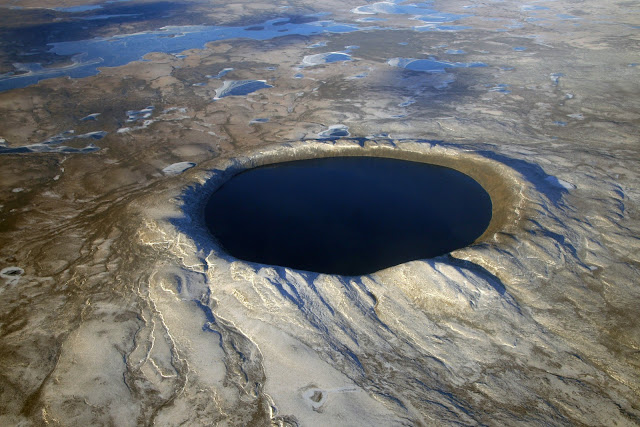The Pingualuit Crater, formerly called Chubb Crater and later New Quebec Crater, is a young impact crater, by geological standards, located on the Ungava Peninsula, in the administrative region of Nord-du-Québec, in Quebec, in Canada. It is 3.44 km (2.14 mi) in diameter, and is estimated to be 1.4 ± 0.1 million years old (Pleistocene).
The crater is exposed to the surface, rising 160 m (520 ft) above the surrounding tundra and is 400 m (1,300 ft) deep. The 267 m (876 ft) deep annular Pingualuk Lake fills the hollow, and is one of the deepest lakes in North America. The lake also holds some of the purest fresh water in the world, with a salinity level of less than 3 ppm (the salinity level of the Great Lakes is 500 ppm). The lake has no inlets or apparent outlets, so the water accumulates solely from rain and snow and is only lost through evaporation. It is one of the most transparent lakes in the world, with Secchi disk visible more than 35 m (115 ft) deep.
The crater was formed by a meteorite impact 1.4 Ma, as estimated by 40Ar/39Ar dating of impact melt rocks. An analysis of these rocks also revealed planar deformation features as well as the composition of the meteorite itself. The Ir, Ni, Co and Cr enrichments found in impact melt samples suggest that the meteorite was chondritic in nature.
Image Credit: NASA/Jeff Schmaltz
Explanation from: https://en.wikipedia.org/wiki/Pingualuit_crater




wow
ReplyDeletewow
ReplyDeleteAre there living some organisms in the lake (with such a low salinity)?
ReplyDeleteBest,
Jiri
wow can we have a sample of the water.
DeleteVery beautiful!!!
ReplyDeleteHumans shell see eternity, as I hope1!!
ReplyDeleteMarvellous!
ReplyDeleteCalendars and Clocks tell lies "1.4 ± 0.1 million years old" says who a man? How do you date what is not material?
ReplyDeleteWhat is salinity level in purified drinking water
ReplyDelete